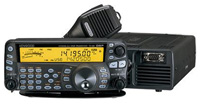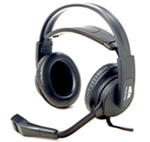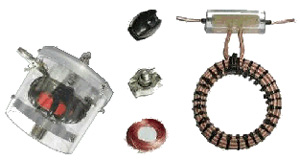|
Home
About me
Interests
Location
Equipment
Feedback
|
|
|
Why i bring new antennas?
Antennas
are a very popular subject among radio amateurs today, as they
have been almost from the beginning of radio science. In fact,
of all the pieces of equipment an amateur owns the
one be probably spends the most time talking about, both on and
off the air , is his antenna system. There are at least two good
reasons for this, First, the antenna themselves
are pretty simple, at least from the standpoint of
circuitry. They contain No transistors, capacitors , resistors,
diodes or even vacuum tubes or any kind of difficult circuit
difficult to understand. Antennas are usually simply
pieces of wire or tubing with perhaps a transformer thrown
in for impedance matching . Thus, they are at least easy to see.
The second reason for the great deal of attention antennas get
is their performance . Every ham who has been around very long
knows that there is no easier way to improve his station's
capabilities than to improve his antenna. When a significant
change for the better is made in the antenna, the improvement in
the station's ability to communicate is immediately
apparent, on both transmission and reception. One thousand Euros
( the usual price of store bought kilowatt amplifier on these
days) spent on an antenna installation will do worlds more good
for amateur than will a similar amount spent on a big "pair of
boots" . Also, antennas are very popular because they are easier to
homebrew than most pieces of equipment . and easier to
make operate properly after their construction. Thus, the
antenna deserves it's popularity. And if this so, then the
simple theory behind the antenna deserves to be understood
by all of us. So, the reason for this comment - will
discuss the very simple theory of antenna gain, efficiency,
capture area and effective height. These are subjects of
which very few amateurs seem to have a good grasp today. Much is
heard about antenna "gain" especially, but few seem to have
exact understanding of what they are speaking about. Perhaps
this comment will help to clear up a little of confusion.
An antenna can
basically be thought of as advice converting energy from one
form to another. When an electromagnetic wave strikes as antenna
we find that electrical power is available at its terminals. On
the other hand, when we apply electrical power to the terminals
of the antenna , we find that electromagnetic field (wave)
is radiated by the antenna.
This property of
working both "backward and forward" is called reciprocity and is
characteristic of antennas
Most of us
realize that it is Electromagnetic field s or "waves" that
provide invisible link between transmitting and receiving
stations in radio communications system. But the fact is that no
one, even the professionals, knows just what a electromagnetic
field is.
Short
vertical antennas are of interest to many amateurs, Every mobile
whip antenna is short, much too short, at frequencies, 7,
3.5Mhz. Also, not everyone is blessed with sufficient clear
space for erection of horizontal dipoles at those frequencies,
For such amateurs, the short vertical is a solution which may be
attractive , especially for use on 40 and 80mts. this is a
discussion for those who care to know something about how
such antennas can work, and what their limitations are. Since
this type of antenna is electrically short, something as to be
done to lengthen it so that will resonate and take power from
the transmitter. One of the simple ways of resonating a short
antenna is by use of a series loading coils.
EQUIPMENT
This
page contains links to equipments used by project members on
this Amateur Radio Adventure, software programs and components
developed by the project, and to other tools we've found useful
and collected here for your convenience.
I will take my I PRO Traveller
Antenna and Vertical Wire Dipoles (VDA).He suggested that while he'd squeeze me in
somewhere if it became necessary, he also had a well-equipped
suitcase portable station Kenwood TS480S with internal tuner,
and ALINCO DM33OMVE power supply. I've permission for the
antennas which perhaps I could operate from the cogttage? I scoped
out the resort and found the perfect spot to string up the G5RV
from a 4th floor stairwell window over to a convenient tree in
the courtyard and our 2nd floor balcony was exactly half way in
between. I thought long and hard about how to ask about putting
up the antenna. In the end I decided it sounded better to
describe it as 'a wire aerial for my radio' instead of a
'hundred foot long ham radio antenna'. I shouldn't have worrried.
The owner of the cottage specialized in catering to their guests needs and the
best line I heard on the whole trip was 'Are you sure you
wouldn't like us to have the maintenance workers put up your
antenna for you?' Now that's service! With the license in hand
(it's actually a very official looking 10-page document, printed
and bound!) and the G5RV hung in the garden it was time to get
on the air. I had never used an Icom IC-7000 before but I knew
what I wanted to do so after an hour of flipping through the
manual I had the mic gain, ALC and compression set up and
programmed the voice memories. |
|
KENWOOD |
|
Every body know
that if you prefer one Manufacteur Equipment you never change if
you prefer Yaesu, ICOM, Kenwood , Ten-tec etc, . We are talking
about OM with some years on experience , myself I never change
from Kenwood, i've already operate under diferent conditions or
with Yaesu or ICOM even with TEN-TEC and Drake. We can start
here a discussion, but i've a costumate to listening good
reception on my Kenwood s ,that's the reason |
| |
 1
KENWOOD Transceiver 1
KENWOOD Transceiver |
 |
|
Features |
 |
160-6 meters |
 |
Electronic Memory
Keyer |
 |
100 Alpha Memories |
 |
100 Watts Output
(200 on HX) |
 |
Wide-Narrow
Deviation |
 |
Remote head |
|
 |
Audio D.S.P. |
 |
Digital NL |
 |
10 Hz Tuning |
 |
1750 Hz Tone |
 |
Multiple Scan |
 |
Time-out Timer |
|
|
| |
|
The Kenwood
TS-480SAT is an all mode HF plus 6 meter amateur transceiver. It
features AF digital signal processing on both receive and
transmit. A quad-mixer provides receiver dynamic range
equivalent to that of the TS-950 class. Receive coverage is 500
kHz (30 kHz VFO) to 60 MHz and direct frequency keypad entry is
supported. The stand-alone LCD control panel features its own
speaker and be placed up to 16 feet away from the main unit.
This radio features attractive back lighting of the display
and the controls! The supplied tabletop panel brackets is
convenient for base use. 100 Alphanumeric memories are available
and multiple scan functions are supported including: program
scan, VFO scan, memory scan, group scan, subtone scan and CTCSS
scan. The TS-480SAT can transmit 100 watts (5 watt minimum RF
output for QRP work). Many operational parameters can be set to
your operating preferences via the menu system. Up to two
optional IF filters may be added. ARCP-480 and ARHP-10 control
software downloads are available free from www.kenwood.net . |
| |
|
Note: The
TS-480HX is similar, but provides 200 watts (100 on 6 meters)
and does not have the built-in antenna tuner. The rear panel of
the TS-480HX has dual fans and dual DC inputs. |
| |
|
You may also
obtain technical support by e-mail or telephone at [Kenwood];
and by e-mail . You can also contact GITEI |
 1
HEIL Headphones Model PROSET 1
HEIL Headphones Model PROSET |
|
 |
|
|
The PRO-SET Headphones |
| |
|
This is also
great part of the equipment, I just tell you I've two pairs, one
for my own station and the other I've use to play radio on
portable, DXpeditions also on Fieldays. Very confortable it's a
great piece for DX'er with HC4 piece on Microphone works very
well with all amateur equipments.When you use for the first time
, you down't want to miss for other times, and help you on the
pile-ups.
|
|
You may also
obtain technical support by e-mail or telephone at HEIL;
and by e-mail. You can also contact CLASSICINTERNATIONAL |
 1
ASUS Laptop 1
ASUS Laptop |
|
|
 |
| |
| |
 1
VIBROPLEX CW Paddle 1
VIBROPLEX CW Paddle |
|
 |
|
|
We Love
CW,
but we still a humbles CW Operators!
" beeleave me
I'm trying to improve everyday, and maybe 10 years from now I
could transmit and receive fast like some friends "Marq,CT1BWW
"I Canīt
perform CW Pile-ups because I still have a hard hears." So if
you can't hear us on any Phone Frequencies take a look on CW
but be pacience!
The Vibroplex Iambic is the modern descendent
of the Original. It incorporates the traditional Vibroplex look
for use with modern electronic keyers. The code speed with the
Iambic depends upon the particular electronic keyer with which
it is operated. And, you get the same crisp operation at 5 words
per minute as you do at 50+ wpm.
The Iambic paddle allows the user to benefit
from the automatic dot/dash insertion of the modern keyer while
maintaining the quality and tradition Vibroplex is noted for
throughout the world. No other keyer does it with such
effortless ease.
You may also
obtain technical support by e-mail or telephone at VIBROPLEX;
and by e-mail. |
 1
ALINCO Power Suplly 1
ALINCO Power Suplly |
|
 |
|
Features
|
 |
|
 |
|
You may also
obtain technical support from Peter Bogner DK1RP by e-mail or telephone at DX
Wire; and by e-mail . |
|

These fiberglass telescopic poles
are very
good as a non-conductive antenna
support. Unfortunately,
these products do
not achieve the strength
and durability of metal poles
.However,
these
poles
are very light,
extremely
compact for transport and
have a affordable price. Below
you will find a
overview chart on
our models.
Pole dimensions: full extracted
length (height)11,5m
MIDI, grey
bottom diameter:
59mm top diameter:5,5mm
weight: 3.3kg2,2kg
transportation length:85cm
fits still in a large travelbag
This a great
piece, We decide to integrate as a part of equipment for VDAs
Antennas on portable operations as well. T |
|
|
We also us the
Spiderbeam Masts We decide to integrate as a part of equipment for Low
Band Operations. These heavy duty poles are very well suited for
building 40/80/160m wire GP or inverted L antennas. They can
also easily support temporary lightweight 1 Element Quad or
Delta loops for 20-10m, and dipoles for all bands, especially
when used with open wire feedline. (Most baluns would be
somewhat heavy). 4-6 poles could be used to build lightweight
beams for 40 or 80m. |
| |
|
Even the top
segment is 8mm in diameter (and 1.4mm wall thickness), so the
poles can be used to their full 12m length - unlike other poles
where the top segment is very thin as a whip. During our tests
we were able to put 80m inv vee dipoles (made from 1mm diameter
enameled copper wire (AWG 18) and open wire feedline) RIGHT AT
THE TOP of the 12m pole... No way you can do this with a regular
"fishing rod"!
At 9-10m height, the poles can easily support small VHF/UHF
yagis.
The best (and cheapest) wire to use for such applications
(verticals, loops, dipoles etc.) is AWG 18 (= 1mm diameter)
enameled copper wire or similar. Thin fishing monofilament (1mm
diameter) or similar rope is very suitable for guy lines.
Of course, a single person can still put up these poles very
easy within minutes. |
| These are very
strong poles, with a much greater wall thickness (up to 2mm!)
than the usual "fishing rod" types. They are wound with a
special reinforcing winding technique (several layers of
fiberglass are wound in alternating direction (criss/cross
winding), thus greatly increasing lateral and linear strength.
Stronger joints are achieved by a much larger overlap between
the individual tube segments than usual. |
| With continuing
efforts to make portable equipment ,even more rugged and durable
SPIDERBEAM have now developed a new "HEAVY DUTY" version of our
well-known 12m pole. The first prototypes were tested last
November/December during 120km/h winds at the North Sea coast
and performed just great!. |
Pole dimensions:
full extracted length (height): 12m (40ft)
transportation length: 1.18m (3ft 10'')
weight: 3.3kg (7lbs)
bottom diameter: 55mm (2 1/6'')
top diameter: 8mm (1/3'')
wall thickness: 1.4 - 2mm (1/18" - 1/12")
number of segments: 12
segment length: 3ft 10" (1.18m)
Pole material: Black Fiberglass, UV protected |
| |
 Gustav
Kelemen Antena Gustav
Kelemen Antena |
|
 |
|
The DIPOL and KURZ-DIPOL Over past 15
years when I sarted on DX'peditions (May 1990 with CT0B) I use
this great antennas , of course if you are operating from a
Lighthouse and if you have permition to get the top, it's very
easy to put several dipoles from the top, if you have luck to
have some trees, or on an island with coconuts so you can mount
the dipoles and kurz-dipoles (short dipoles) the same way.
I've heard from others and Usually I said... I'm going on
Dxīpedition on island but island with coconuts
Also very easy on transport . I've dipole specialy for WARC
Bands, for 40 and 80 Meters, and for normal bands 10,15 and 20
Meters. |
| You may also
obtain technical support by e-mail or telephone at GUSTAV
KELEMEN; and by e-mail . |
|
SOFTWARE |
| |
|
UCX Log |
 |
This is my NEW LOGGING created
by DL7UCX this software
can be downloaded via the link
UCX LOG at internet . It's a program designed to do contest logging and some general logging.
It is not a general logging program with award tracking etc. but
it is mainly a contest program. Also very good for using as a DXpedinionary tools on any laptop .
The program can be used on Windows NT/2000/XP/Vista/7/8/10
(Windows 95/98/Me possibly with restrictions) . Try to use this log software
and explore all facilities.Log
book with unlimited number of QSOs. Determination of DXCC/WAE
country, CQ/ITU zone, beam direction and distance and QSOs
before. Comfortable CW and speech generation (output LPT / COM /
WinKey / Soundcard). Digital modes by coupling with Fldigi and
MMTTY engine, integral BPSK/QPSK. World map in Rectangular or
Great Circle projection with gray-line, short and long path.
Spectrum analysis and audio recorder (soundcard). DXpedition mode and QSO statistics.
NCDXF/IARU Beacon monitoring.
DX cluster / bandmap via TNC/Telnets/WWW with many filters (DXCC
and IOTA detection), takeover to log and TRX. Import/export:
ADIF, ASCII, Cabrillo, STF, EDI, LOTW, eQSL, Clublog, RSGB-IOTA.
Different operators with own settings possible. Flexible QSL
print for cards and labels with optional background images.
Log Cloud -
Backup or synchronize logs on UcxLog webserver - Web upload of
own frequency.
Safe database with extreme fast call sign search.
You may also obtain technical
support by e-mail Please take a look Here on
UCX Forom
UCX Forum
|
|
N1MM Free
Contest Logger |
 |
The software
can be downloaded via the links at internet. It's a freeware
program designed to do contest logging and some general logging.
It is not a general logging program with award tracking etc. but
it is mainly a contest program. Also very good for using as a
DXpedinionary tools on any laptop .
The program can be used on Windows 95/98/ME and on Windows
NT/2000/XP.DOS is not supported. Try to use this log software
and explore all facilities.Try
to use also this log software and explore all facilities.
Personnaly I've four different log software on my laptop, and
LOOGER32 is one of my choice.You can visit the site here.You may also obtain technical
support by e-mail Please take a look Here N1MM. |
|
MixW Multimode
software |
 |
|
MixW is a
multimode program for HAMs. It will help you in regular and
contest QSOs. This program have many features which give you
almost automatic processing of a QSO. |
MixW supports:
SSB, AM, FM, CW, BPSK31, QPSK31, FSK31, RTTY, Packet (HF/VHF),
Pactor (RX only), AMTOR (FEC), MFSK, Hellschreiber, Throb, Fax
(RX only), SSTV, MT63.
MixW does not require a TNC. The only requirement is that you
must have a computer running
Windows 9x, ME, NT4, 2000 or XP operating system, and a
compatible soundcard, MixW
RigExpert or MixW
RigExpert Tiny
interface.
You may download the
full-functional version (with 15-day trial period) of MixW and
try it right now.Please take a look HERE MixW. |
|




|
|

